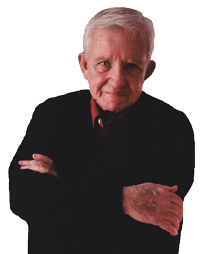This post is part two of a series about New York in the ’50s. You can read the first here.
A proud and private man, known as an eccentric, even in the jazz world, Thelonious Monk was given to wearing capes, an assortment of hats and caps from silk to fur, and sunglasses with bamboo rims. One night in 1957 he was playing his solo set of the evening at The Five Spot when he was interrupted by a shout from the audience. A man who must have had far too many of the Five Spot’s fifteen cent beers yelled “We wanna hear Coltrane!”
Monk said “Coltrane bust up his horn.”
After the intermission, when Monk came out again and began to play, the heckler became more hostile and asked Monk what he meant when he said Coltrane “bust up his horn.” Monk stood up at the piano and delivered the following dissertation:
“Mr. Coltrane plays a wind instrument. The sound is produced by blowing into it and opening different holes to let air out. Over some of these holes is a felt pad. One of Mr. Coltrane’s felt pads has fallen off, and in order for him to get the sound he wants, so that we can make better music for you, he is in the back making a new one. . .you dig?”
The jazz critic Nat Hentoff called The Five Spot ‘the most significant jazz club since the clubs of Chicago in the twenties where Louise Armstrong played. The house group was Thelonious Monk and and John Coltrane. Musicians and lay people lined up three and four deep to get in.”
Coltrane and Monk were followed by the bass player Charles Mingus and his group.
Allen Ginsberg told me “I got to know Charlie Mingus when he played at The Five Spot, and later at his wedding in Milbook, New York. I’d just come back from India and I knew monochromatic chanting – there were a lot of musicians interested in that mode, like Coltrane. I did a recording of it with Coltrane’s drummer. At Mingus’s wedding I was chanting mantras to Shiva, to Buddha. . .”
I heard Mingus more than once at The Five Spot. If people in the audience were talking, he stopped playing and waited for the talking to stop. He said if people wanted to talk they should go outside. If people continued talking, he ushered them out. The jazz musicians of New York in the Fifties brought dignity to their performances. One of the best and most creative groups was The Modern Jazz Quartet. They did not play in clubs or bars. They gave concerts. They wore tuxedos when they played.
When I want to bring back the feel of the era, evoke the people and places, I play The Modern Jazz Quartet recording of their own composition, “No Sun in Venice.” Margot Hentoff, wife of the jazz critic and herself a fine writer said “The MJQ was the Fifties.” There is a dvd documentary about Thelonious Monk called “Straight, No Chaser.” It shows his travels in New York and Europe and sometimes he sits down at the piano and plays songs like “Just a Gigolo” and “I Should Care.” He plays with an eloquence that makes the songs new. Still. Now.

